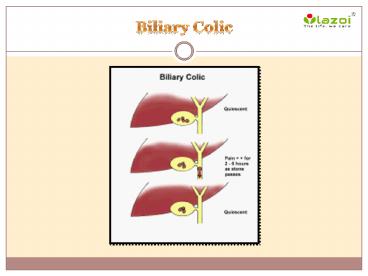Biliary Colic - PowerPoint PPT Presentation
Title:
Biliary Colic
Description:
Biliary colic, also known as gallbladder attack, is a steady or intermittent pain in the upper abdomen, usually under the right side of the rib cage. Biliary colic mainly occurs when gallstones temporarily block the bile duct during the contraction of the gallbladder. – PowerPoint PPT presentation
Number of Views:490
Title: Biliary Colic
1
Biliary Colic
2
What is Biliary Colic?
- Biliary colic, also known as gallbladder attack,
is a steady or intermittent pain in the upper
abdomen, usually under the right side of the rib
cage. Biliary colic mainly occurs
when gallstones temporarily block the bile duct
during the contraction of the gallbladder.
Biliary colic increases the gallbladder wall
tension. In many cases, the pain of this biliary
colic resolves over 30 - 90 minutes, as the
gallbladder relaxes and the obstruction is
relieved. - Gallstones are a general case for a common man,
because they rarely cause any symptoms and many
people are unaware of their presence.
Approximately one-third of the population which
is affected by gallstones will develop the
painful symptoms of biliary colic.
3
What is the cause of Biliary colic?
- Biliary colic happens when the gallbladder
contracts and causes a gallstone to temporarily
block the duct that drains the gallbladder.
Gallstones are hard masses that form in the
gallbladder. They can be small and numerous, or
large and few. Gallstones form due to chemical
imbalances in bile or infrequent or incomplete
emptying of the gallbladder. - Increased pressure in the gallbladder causes the
pain and discomfort associated with biliary
colic.
4
Symptoms
- FAQ's
- 1. What are the symptoms of Biliary colic?
- The person suffering from biliary colic
complains of an ache or pain in the upper-right
part of the abdomen. In some cases, this pressure
can spread towards the back of the right
shoulder. Other symptoms include - Nausea
- Vomiting
- 2. What are the main risk factors associated
with biliary colic? - The main risk factors associated with biliary
colic are - Gender Women are more likely to develop
gallstones than men. This is because estrogen,
the female sex hormone, can make gallstones more
likely to form. - Heredity A family history of gallstones
increases the risk of gallbladder problems.
5
Symptoms
Continue
- Age Gallstones are more common in people older
than 40. - Ethnicity Native Americans and Mexican-Americans
are more prone to gallstones than other groups. - Body weight Overweight or obese people may have
more cholesterol in their bile, which helps
stones form. Rapid weight loss and fasting also
raises the amount of cholesterol in the bile. - 3. What can be the possible ways to prevent
bilary colic? - To prevent biliary colic, one should take the
following prevention - Maintaining a healthy lifestyle
- Avoiding fatty food and high-fat dairy products
- Dietary modification
- 4. How is biliary colic diagnosed?
- You may be referred to a gastroenterologist if
you have biliary colic. Gallstones are diagnosed
using medical history, laboratory tests, and
medical imaging.
6
Symptoms
Continue
- The standard imaging test is an ultrasound. Your
doctor will pass a special wand across your
belly. It bounces sound waves off the inner
organs and can reveal the presence of gallstones.
In some cases, your doctor may order computed
tomography (a CT scan), magnetic resonance
imaging (MRI), or other diagnostic tests. - 5. How is biliary colic treated?
- The usual treatment for gallstones is surgery to
remove the gallbladder. This is known as
a cholecystectomy. Laparoscopic surgery, or
keyhole surgery, is the most common way to
perform a cholecystectomy. It's often performed
as an outpatient procedure. In some cases, open
surgery may be required. The surgeon makes an
incision in the abdominal area. For this
procedure, a hospital stay is required during
recovery. - If you can't have surgery, your doctor can try
other procedures to dissolve or break up the
gallstones. In such cases, the gallstones may
come back within a few years.
7
Treatment
- Which specialty of doctor is to be consulted for
the treatment of Biliary Colic in India? - A Gastroenterologist is to be consulted for the
treatment of Biliary Colic in India. - Which hospital is to be preferred for the
treatment of Biliary Colic in India? - Medanta - The Medicity hospital in India is to be
preferred for the treatment of Biliary Colic in
India.
8
CONNECT WITH US
- Logon to
- www.lazoi.com
- Like us on Facebook
- https//www.facebook.com/LazoiTheLife
- Follow us on Twitter
- https//www.twitter.com/lazoithelife
- Follow us on Pinterest
- https//www.in.pinterest.com/lazoithelife































